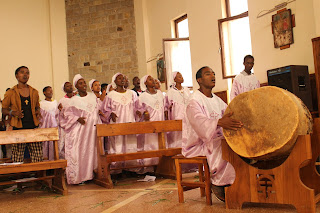 |
| Donkeys carrying firewood to the market. |
If you thought driving on I-395 / I-495 in D.C. or the
Palmetto Expressway in Miami was a pain, you should try driving through the
streets of Dilla. You can find every
conceivable obstacle to crash into, yet somehow hardly any accidents occur in
this organized chaos. So what can you encounter while behind the wheel you ask?
How about:
 |
| Donkey cart with jerrycans. |
Rickety old wooden carts pulled by donkeys.
These carts can be stacked with jerrycans
filled with water or firewood that is sold in the market.
The donkey carts are usually led by children
on foot but sometimes you see them standing on the cart and driving it as if it
were a Roman chariot in the coliseum.
 |
| The bajaj. |
Blue bajajs skirting in and out of lanes and vehicles. One
of the more popular forms of local transportation, it can seat between 3-4
people, depending on the size of the person, and you can share it with other
travelers, similar to Uber Carpool.
The
bajaj will take you up and down the main asphalted road only, and the cost is
merely one to two birr per person.
Motorcycles also serve as transportation from the main road
to the homes and villages that are several kilometers inland and are serviced
only by dirt roads. They take one
passenger in the back and a ride can cost about 10 birr. College students use this mode of transport a
lot to get to the university campuses that are about 5 kilometers from the main
road. The drivers and passengers rarely
use helmets, if not at all, and can be dangerous which is what happened
recently to a young lad who lost his life in a motorcycle crash.
 |
| A main pick-up/drop-off transportation point for locals. |
A collective taxi, or mini-van, can also transport groups of
people from the main road to the homes and villages in the outskirts of
Dilla. These minivans also serve as
long distance transport to other cities such as Hawassa (2.5 hours away), Ziway
(circa 4.5 hours away), or Addis Abeba (about 8 hours away).
 |
| A lorry stacked with jerrycans. |
Lorries, typically the Isuzu brand, are constantly driving
up and down the main road carrying construction materials or heavy-duty
machinery.
The main road in Dilla is
currently under construction as it serves as the main transportation link to
the Kenyan border town of Moyole.
This
road has been under construction for two years already but progress has been
slow so it does not look likely to end anytime soon.
 |
| One of the lorries on the main road in Dilla. |
First-level buses are the equivalent of your yellow school
bus or Greyhound bus. This name amuses me because I wonder what the second- or
third-level buses may look like but I have yet to encounter any of these.
Then there are the people who casually walk across the
roadways. It is essentially no-man’s land as you are not guaranteed safe
walking passage. I don’t believe crosswalks exist here yet and if they do,
drivers rarely observe the rules for pedestrians. On the main highway stretches between cities,
you can find people selling their wares or fruits on the side of the street, or
more often than not, right out in the middle of the street, thus forcing you to
swerve your vehicle around them, as if they thought you would stop and buy
something from them.
 |
| The first level bus. |
Lastly, my favorite obstacles to dodge on the streets are
the animals, mainly goats, cows, and stray dogs.
They wander to and fro without supervision so
I always wonder how they get back home. Apparently, they have some internal GPS
that guides them back to their stable at night. I am always amazed that there
is not more road kill on the streets but somehow everyone manages to avoid
hitting them. However, there is a good reason for that. Anyone who maims or
kills a farm animal, e.g. goat, cow or donkey, must make payment to the animal
owner. But this isn’t just any regular payment. It can sometimes be a hefty fee
since these animals are considered important assets so they calculate a certain number of years that the animal would have provided the family with a steady
income.
 |
| Our Landcruiser and long distance transportation between cities. |
The remaining vehicles on the road are mainly pick-ups or the LandRover type since there are a lot of dirt and mud roads so a sturdy automobile with 4-wheel drive is a necessity. I have not had the pleasure (or stress) of driving here yet but being a passenger is enough for the experience. Suffice to say, regular road rules don’t really apply. You
just kind of drive around on any piece of road that isn’t already occupied with
one of the above.
So we just keep calm and drive on!
 |
| A crowded intersection with pedestrians and makeshift storefronts. |





























